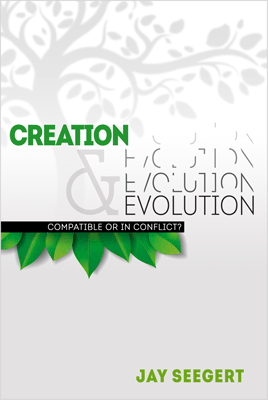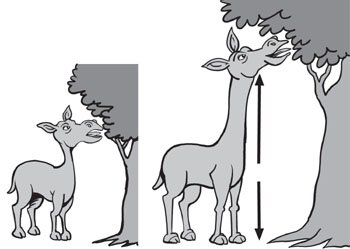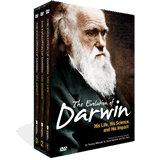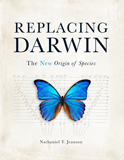
Chapter 28
Do Evolutionists Believe Darwin’s Ideas about Evolution?
Few people have actually read the works of Darwin, and if they did they might be shocked to read some of Darwin’s ideas.

This controversy can’t be solved by merely listing both views of the facts. Extremely intelligent and knowledgeable scientists in both camps show that it can’t just be about facts. Discover what makes the difference!
Charles Darwin first published his ideas on evolution over 150 years ago. In those 150 years we have come to understand the complexity of life, and many new scientific fields have shed light on the question of the validity of Darwin’s evolutionary hypothesis. Few people have actually read the works of Darwin, and if they did they might be shocked to read some of Darwin’s ideas. In this chapter we will take a look at what Darwin and other early evolutionists believed and how those ideas have changed over time.
Darwin was wrong on many points, and there would be few who would disagree with this claim. But if Darwin was wrong on some points, does that mean that the entire hypothesis of evolution is proven wrong?
What Is Evolution?
Like many words, evolution has many different uses depending on its context. The general concept of the word is “change over time.” In that sense, one might say that a butterfly evolves from an egg to a caterpillar to a winged butterfly and a child evolves into an adult. There is no disputing that individual organisms change over time. However, using the word in this way is quite misleading for the origins debate. Darwin’s hypothesis involves a very different concept.
As evolution is used in this chapter and in all science textbooks, natural history museums, and science programs on television, it refers to the biological idea that all life on Earth has descended from a single common ancestor. There are many different variations on this theme as well as several explanations of how the first organism came into existence from non-living matter. Examining some of the historical evolutionary positions and comparing them to the ideas that are popular in scientific circles today shows how much those concepts have changed. In general, evolution will be used to refer to the concept of molecules turning into men over time. This concept of evolution is in direct opposition to the biblical account of creation presented in the book of Genesis.1
Evolution—An Ancient Idea
The concept of molecules-to-man evolution is certainly not a new idea. Several Greek philosophers before the time of Christ wrote on the topic. For example, Lucretius and Empedocles promoted a form of natural selection that did not rely on any type of purpose. In De Rerum Natura (On the Nature of Things) Lucretius writes:
And many species of animals must have perished at that time, unable by procreation to forge out the chain of posterity: for whatever you see feeding on the breath of life, either cunning or courage or at least quickness must have guarded and kept that kind from its earliest existence. . . . But those to which nature gave no such qualities, so that they could neither live by themselves at their own will, nor give us some usefulness for which we might suffer to feed them under our protection and be safe, these certainly lay at the mercy of others for prey and profit, being all hampered by their own fateful chains, until nature brought that race to destruction.2
This stands in opposition to the thinking of Aristotle, who promoted the idea of purpose in nature. Aristotle also imagined forms of life advancing through history, but he believed nature had the aim of producing beauty.3 This idea of purpose in nature, or teleology, is later seen in the works of Thomas Aquinas and other Christian philosophers.
The concept of evolution was not lost from Western thinking until Darwin rediscovered it.
The concept of evolution was not lost from Western thinking until Darwin rediscovered it—it was always present in various forms. Because much of the thinking was dominated by Aristotelian ideas, the idea of a purposeless evolutionary process was not popular. Most saw a purpose in nature and the interactions between living things. The dominance of the Roman Catholic Church in Europe (where modern science was born) and its adherence to Aristotelian philosophies also played a role in limiting the promotion of evolution and other contrary ideas as these would have been seen as heresy. As the Enlightenment took hold in Europe in the 17th and 18th centuries, explanations that looked beyond a directed cause became more popular.
Erasmus Darwin
Coming to the mid-to-late 18th century, Kant, Liebnitz, Buffon, and others began to talk openly of a natural force that has driven the change of organisms from simple to complex over time. The idea of evolution was well established in the literature, but there seemed to be no legitimate mechanism to adequately explain this idea in scientific terms. Following the spirit of the Greek poets Lucretius and Empedocles, Erasmus Darwin, the atheist grandfather of Charles, wrote some of his ideas in poetic verse. Brushing up against the idea of survival of the fittest, Erasmus spoke of the struggle for existence between different animals and even plants. This struggle is a part of the evolutionary process he outlines in his Temple of Nature (1803) in the section titled “Production of Life”:
Hence without parent by spontaneous birth
Rise the first specks of animated Earth;
From Nature’s womb the plant or insect swims,
And buds or breathes, with microscopic limbs.4
And he continues:
Organic Life beneath the shoreless waves
Was born and nursed in Ocean’s pearly caves;
First forms minute, unseen by spheric glass,
Move on the mud, or pierce the watery mass;
These, as successive generations bloom,
New powers acquire, and larger limbs assume;
Whence countless groups of vegetation spring,
And breathing realms of fin, and feet, and wing.5
Starting with spontaneous generation from inanimate matter, Erasmus imagined life evolving into more complex forms over time. He did not identify any mechanisms that may have caused the change, other than general references to nature and a vague driving force.
In the introduction to this work, Erasmus Darwin states that it is not intended to instruct but rather to amuse, and he then includes many notes describing his ideas. Despite his claimed-to-be-innocent intentions, this poem lays out the gradual, simple-to-complex progression of matter to living creature—a view very consciously different from the biblical account of creation which the vast majority of his contemporaries knew and believed. He traces the development of life in the seas to life on land with the four-footed creatures eventually culminating in humans and the creation of society. There is no doubt that when Charles began his studies, the idea of evolution apart from the supernatural was present in Western thought (even in his own extended family). The arguments in support of special creation were certainly prominent, but evolutionary ideas were being pressed into mainstream thinking in the era of modernism.6
To underscore the early acceptance of evolution, the following passage from Zoonomia (3 vol., 1794–1796) illustrates Erasmus Darwin’s belief that all life had come from a common “filament” of life.
From thus meditating on the great similarity of the structure of the warm-blooded animals . . . would it be too bold to imagine that, in the great length of time since the Earth began to exist, perhaps millions of ages before the commencement of the history of mankind would it be too bold to imagine that all warm-blooded animals have arisen from one living filament?7
Lamarckian Evolution or Use and Disuse
In France, and at the same time as Erasmus, Jean Baptiste Lamarck developed his theories of the origin and evolution of life. Initially, he had argued for the immutability of species, but in his later works he laid out a clear alternative to the special creation of plants and animals. Lamarck believed that the geology of the Earth was the result of gradual processes acting over vast periods of time—a view later to be known as uniformitarianism. Lamarck developed four laws of evolution and put them forward in his Philosophie Zoologique published in 1809. Lamarck proposed that an internal force and the need for new organs caused creatures to develop new characteristics. Once developed, the use or disuse of the organs would determine how they would be passed on to a creature’s offspring. This idea of the transmission or inheritance of acquired characteristics is the hallmark of this model of evolution.

In Lamarckian evolution, animals change due to environmental factors and the use or disuse of a feature. For example, a giraffe’s neck will get longer over time as it continually stretches it to reach higher leaves on trees.
Lamarck’s mechanism of use and disuse of characters was widely rejected in his lifetime, especially by the prominent French naturalist Georges Cuvier, and was never supported by observations. Lamarck did attempt to explain how the characteristics were inherited, but there was still no clear biological mechanism of inheritance that would support his claims. Lamarck also proposed a tree of life with various branching structures that showed how life evolved from simple to complex forms. Much of what Lamarck proposed seems unreasonable to us today with a modern understanding of genetics. A husband and wife who are both bodybuilders will not have an extraordinarily muscular child—that acquired trait does not have any affect on the genetic information in the germ cells of the parents’ bodies. However, recent research has revealed instances of bacterial inheritance that appear to be very Lamarckian in nature. Future research in this area may reveal that Lamarck was correct to some degree. But there are many good reasons to expect that this would provide no support for the idea of molecules-to-man evolution.8
Darwinian Evolution
Charles Darwin was at least familiar with all of these different views, and their influence can be found throughout his writings. Darwin often referred to the effects of natural selection along with the use or disuse of the parts. The legs and wings of the ostrich, the absence of feet and wings in beetles, and the absence of eyes in moles and cave-dwelling animals are all mentioned by Darwin as a result of use or disuse alongside natural selection.9 Exactly how this process happened was a mystery to Darwin. He proposed the idea of “pangenesis” as the mechanism of passing traits from parent to offspring. This idea is not significantly different from Lamarck’s, for it relies on the use and disuse of organs and structures that are passed on to offspring through pangenes over vast ages.

Darwin originally proposed that natural selection would be the primary mechanism acting to change organisms over millions of years. He was not aware of the role of mutations in heredity.
In his work The Variation of Animals and Plants under Domestication, Darwin suggested that gemmules are shed by body cells, and that the combination of these gemmules would determine the appearance and constitution of the offspring. If the parent had a long neck, then more gemmules for a long neck would be passed to the offspring. In Darwin’s defense, he was not aware of the work of his contemporary, Gregor Mendel. In his garden in the Czech lands, Mendel was studying the heredity of pea plants. Neither man knew of the existence of genes, or the DNA genes are composed of, but both of them understood there was a factor involved in transmitting characteristics from one generation to the next. Despite evidence from experiments conducted by his cousin Francis Galton, Darwin clung to his pangenesis hypothesis and defended it in his later work Descent of Man.
Darwin believed that all organisms had evolved by natural processes over vast expanses of time. In the introduction to Origin of Species he wrote the following:
As many more individuals of each species are born than can possibly survive; and as, consequently, there is a frequently recurring struggle for existence, it follows that any being, if it vary however slightly in any manner profitable to itself, under the complex and sometimes varying conditions of life, will have a better chance of surviving, and thus be naturally selected. From the strong principle of inheritance, any selected variety will tend to propagate its new and modified form.10
Darwin’s belief that slight modifications were selected to produce big changes in organisms over the course of millions of years was the foundation of his model for the evolution of life on Earth. We know today that Darwin’s notion of gemmules and pangenes leading to new features or the development of enhanced characteristics is a false notion. However, that does not mean, by itself, that Darwin’s conclusion is wrong—just that his reasoning was faulty.
Neo-Darwinian Evolution and the Modern Synthesis
The discovery of DNA and the rediscovery of Mendel’s work on heredity in pea plants have shown that Darwin’s hereditary mechanism does not work. But his conclusion of molecules-to-man transformation over millions of years is still held as true by proponents of evolution. In the early 20th century, Mendelian genetics was rediscovered and it came to be understood that DNA was responsible for the transmission and storage of hereditary information. The scientific majority was still fixed on a naturalistic explanation for the evolution of organisms. That evolution happened was never a question—finding the mechanism was the goal of these naturalistic scientists.
Mutation of genetic information came to be viewed as the likely mechanism for providing the raw material for natural selection to act on. Combining genetic studies of creatures in the lab and in the wild, models of speciation and change over time were developed and used to explain what was seen in the present. These small changes that resulted from mutations were believed to provide the genetic diversity that would lead to new forms over eons of time. This small change was referred to as “microevolution” since it involved small changes over a short amount of time. The evolutionists claim that the small changes add up to big changes over millions of years, leading to new kinds of life. Thus, microevolution leads to “macroevolution” in the evolutionary view. However, the acceptance of these terms just leads to confusion, and they should be avoided.

After the discovery of DNA and its role in inheritance, evolutionists pointed to mutations in the DNA as the source for new traits. These accidental mutations provide differences in the offspring that can be selected for. This selection is believed to lead to new kinds of life.
This is not fundamentally different from what Charles Darwin taught; it simply uses a different mechanism to explain the process. The problem is that the change in speciation and adaptation is heading in the opposite direction needed for macroevolution. The small changes seen in species as they adapt to their environments and form new species through mutation are the result of losses of information. Darwinian evolution requires the addition of traits (such as forelimbs changing into wings, and scales turning into feathers in dinosaur-to-bird evolution), which requires the addition of new information. Selecting from information that is already present in the genome and that was damaged through copying mistakes in the genes cannot be the process that adds new information to the genome.
It has become so plastic that it can be molded to explain any evidence, no matter how inconsistent the explanations may become.
Today, evolution has been combined with the study of embryology, genetics, the fossil record, molecular structures, plate tectonics, radiometric dating, anthropology, forensics, population studies, psychology, brain chemistry, etc. This leads to the intertwining of so many different ideas that the modern view of evolution can explain anything. It has become so plastic that it can be molded to explain any evidence, no matter how inconsistent the explanations may become. Even Darwin was willing to admit that there may be evidence that would invalidate his hypothesis. That is no longer the view held by the vast majority of evolutionists today—evolution has become a fact, even a scientific law (on par with the law of gravity), in the minds of many.
To help us see this more clearly, let us take a look at the idea of different races. Darwin published his views on the different races in Descent of Man. Though Darwin spoke against slavery, he clearly believed that the different people groups around the world were the result of various levels of evolutionary development. Darwin wrote the following:
At some future period, not very distant as measured by centuries, the civilized races of man will almost certainly exterminate and replace the savage races throughout the world. At the same time the anthropomorphous apes . . . will no doubt be exterminated. The break between man and his nearest allies will then be wider, for it will intervene between man in a more civilized state, as we may hope, even than the Caucasian, and some ape as low as a baboon, instead of as now between the negro or Australian [Aborigine] and the gorilla.11
This is the conclusion Darwin came to—that different rates of evolution would lead to different classes of humans. He often refers to the distinction between the civilized Europeans and the savages of various areas of the world. He concludes that some of these savages are so closely related to apes that there is no clear dividing line in human history “where the term ‘man’ ought to be used.”12 Consistent with his naturalistic view of the world, Darwin saw various groups of humans, whether they are distinct species or not, as less advanced than others. This naturally leads to racist attitudes and, as Dr. Stephen J. Gould noted, biological arguments for racism “increased by orders of magnitude following the acceptance of evolutionary theory,”13 though this was likely only an excuse to act on underlying social prejudices.
Dr. James Watson (co-discoverer of the double-helix structure of the DNA molecule and a leading atheistic evolutionist) was caught in a storm of evolutionary racism in 2007. The Times of London reported the following in an interview:
He says that he is “inherently gloomy about the prospect of Africa” because “all our social policies are based on the fact that their intelligence is the same as ours—whereas all the testing says not really,” and I know that this “hot potato” is going to be difficult to address. His hope is that everyone is equal, but he counters that “people who have to deal with black employees find this not true.” He says that you should not discriminate on the basis of colour, because “there are many people of colour who are very talented, but don’t promote them when they haven’t succeeded at the lower level.” He writes, “there is no firm reason to anticipate that the intellectual capacities of peoples geographically separated in their evolution should prove to have evolved identically. Our wanting to reserve equal powers of reason as some universal heritage of humanity will not be enough to make it so.”14
Though he later stated that he did not intend to imply that black Africans are genetically inferior, he is being consistent with his evolutionary beliefs. His remarks were considered offensive, even by those who endorse evolution.
Those who would suggest that evolution can explain why all humans have value must battle against those evolutionists who would disagree.
This exposes an inconsistency in the thinking of many evolutionists today—if we evolved by random chance, we are nothing special. If humans evolved, it is only reasonable to conclude that different groups have evolved at different rates and with different abilities, and mental ability could be higher in one group than another. If the data supported this claim, in the evolutionary framework, then it should be embraced. Those who would suggest that evolution can explain why all humans have value must battle against those evolutionists who would disagree. This exposes the inconsistent and plastic nature of evolution as an overarching framework—who gets to decide what evolution should mean? Darwin and Watson are applying the concepts in a consistent way and setting emotion and political correctness aside, when it is deemed necessary. Darwin noted that “it is only our natural prejudice and . . . arrogance” that lead us to believe we are special in the animal world.15
Without an objective standard, such as that provided by the Bible, the value and dignity of human beings are left up to the opinions of people and their biased interpretations of the world around us. God tells us through His Word that each human has dignity and is a special part of the creation because each one is made in the image of God. We are all of “one blood” in a line descended from Adam, the first man, who was made distinct from all animals and was not made by modifying any previously existing animal (Genesis 2:7).
Saltation and Punctuated Equilibrium
Contrasted with Darwin’s view of a gradual process of change acting over vast ages of time, others have seen the history of life on Earth as one of giant leaps of rapid evolutionary change sprinkled through the millions of years. Darwin noted that the fossil record seemed to be missing the transitions from one kind of organism to the next that would confirm his gradualistic notion of evolution. Shortly after Darwin, there were proponents of evolutionary saltation—the notion that evolution happens in great leaps. The almost complete absence of transitional forms in the fossil record seemed to support this saltation concept and this was later coupled with genetics to provide a mechanism where “hopeful monsters” would appear and almost instantaneously produce a new kind of creature (e.g., changing a reptile into a bird). These “monsters” would be the foundation for new kinds of animals.
Saltation fell out of favor, but the inconsistency between the fossil record and the gradualism promoted by Darwin and others was still a problem. The work of Ernst Mayr, Stephen J. Gould, and Niles Eldredge was the foundation for the model of “punctuated equilibrium.” This model explained great periods of stasis in the fossil record punctuated with occasional periods of rapid change in small populations of a certain kind of creature. This rapid change is relative to the geologic time scale—acting over tens of thousands of years rather than millions. This idea is not inconsistent with Darwin’s grand evolutionary scheme. However, it seems that Darwin did not anticipate such a mechanism, though he commented that different organisms would have evolved at different rates. Whether evolution has occurred by gradual steps or rapid leaps (or some combination) is still a topic of debate among those who hold to the neo-Darwinian synthesis of mutations and natural selection as the driving forces of evolutionary change.

Contrary to Neo-Darwinism, punctuated equilibrium tries to account for the lack of fossil intermediates by appealing to rapid bursts of change interspersed in the millions of years. They still rely on mutations and natural selection, but at a much faster rate.
Conclusion
Sir Isaac Newton provided us with a general theory of gravity (and described laws in support of that theory) based on observational science. Even in light of modern understandings, those laws still apply today. Einstein did expand the concepts, but the functionality of Newtonian physics still applies today as much as ever.
What is called Darwinism today bears little resemblance to what Darwin actually wrote.
The same cannot be said for Darwin’s ideas. Darwin’s hypothesized mechanism of natural selection (even with the added understanding of mutations) has failed to provide an explanation for the origin and diversity of life we see on Earth today. His confident expectation that the fossil record would confirm his hypothesis has utterly failed, and the mind-boggling irreducible complexity seen in biological systems today defies the explanations of Darwin or his disciples. To say that evolutionary thinking today is Darwinian in nature can only mean that evolutionists believe that life has evolved from simpler to complex over time. Beyond that, what is called Darwinism today bears little resemblance to what Darwin actually wrote.
All of these ideas of the evolution of organisms from simple to complex are contrary to the clear teaching of Scripture that God made separate kinds of plants and animals and one kind of man, each to reproduce after its own kind. As such, these evolutionary ideas are bound to fail when attempting to describe the history of life and to predict the future changes to kinds of life in this universe where we live. When we start our thinking with the Bible, we can know we are starting on solid ground. Both the fossil record and the study of how plants, animals, and people change in the present fit perfectly with what the Bible says about Creation, the Flood, and the Tower of Babel in Genesis 1–11. The Bible makes sense of the world around us.
The New Answers Book 3
Do you have answers to the big questions about the Christian faith, evolution, creation, and the biblical worldview? Now you get the important information you need regarding the existence of God, global warming and climate change, cloning and stem cells, human and chimp DNA, the importance of Mount St. Helens, and more.
Read Online Buy BookFootnotes
- For an explanation of some of the contradictions between the biblical creation account and the widely held evolution story, see the article “Evolution vs. Creation: The Order of Events Matters!” at www.answersingenesis.org/articles/2006/04/04/order-of-events-matters.
- Sharon Kaye, “Was There No Evolutionary Thought in the Middle Ages? The Case of William of Ockham,” British Journal for the History of Philosophy 14 no. 2 (2006): 225–244.
- Henry Fairfield Osborn, From the Greeks to Darwin (London: Macmillan, 1913), p. 43–56.
- Erasmus Darwin, The Temple of Nature (London: Jones & Company, 1825), p. 13.
- Ibid., p. 14–15.
- Modernism was the dominant philosophy in Western culture from the late 18th to the late 20th centuries. This philosophy placed science as the supreme authority for determining truth. Science was viewed as the “savior” of mankind—eventually finding cures for all diseases, ending war, famine, etc. Though it has been largely replaced by post-modernism, this modernist thinking is still very prominent among scientists and many others in our culture. Post-modernism, on the other hand, is a radical skepticism about anyone’s ability to know truth. Post-modernists argue that truth and morality are relative—there are no absolutes. It also reflects disenchantment with the promises made by modernist philosophers and scientists. Both philosophies reject Scripture as authoritative truth and are based on evolutionary thinking.
- Erasmus Darwin, Zoonomia, volume 1 (Philadelphia, PA: Edward Earle, 1818), p. 397.
- Even if Lamarckian mechanisms are uncovered, the fossil record would not support the evolution story. See Duane Gish, Evolution: The Fossils Still Say No, (Santee, CA: Institute for Creation Research, 1996); Carl Werner, Evolution: The Grand Experiment, vol. 1 (Green Forest, AR: New Leaf Press, 2007); and Living Fossils, vol. 2 (Green Forest, AR: New Leaf Press, 2008). Natural selection can only “select” from existing genetic information (it cannot create new information), and mutations cause a loss or reshuffling of existing genetic information. See Terry Mortenson’s DVD Origin of the Species: Was Darwin Right? (Answers in Genesis, 2007) and John Sanford, Genetic Entropy and the Mystery of the Genome (Lima NY: Elim Publishing, 2005). Also, what bacteria can do should not be directly applied to other forms of life because bacteria are categorically and significantly different. This is explained in Georgia Purdom’s DVD All Creatures Great and Small: Microbes and Creation (Petersburg, KY: Answers in Genesis, 2009).
- Charles Darwin, The Origin of Species (New York, NY: The Modern Library, 1993), p. 175–181.
- Ibid., p. 21.
- Charles Darwin, The Origin of Species and The Descent of Man (New York, NY: The Modern Library, 1936), p. 521.
- Ibid., p. 541.
- Stephen Jay Gould, Ontogeny and Phylogeny (Cambridge, MA: Belknap Press of Harvard University Press, 1977), p. 127.
- Charlotte Hunt-Grubbe, “The Elementary DNA of Dr Watson,” Times Online [London], October 14, 2007, www.entertainment.timesonline.co.uk/tol/arts_and_entertainment/books/article2630748.ece.
- Darwin, The Origin of Species and The Descent of Man, p. 411–412.
Recommended Resources

Answers in Genesis is an apologetics ministry, dedicated to helping Christians defend their faith and proclaim the good news of Jesus Christ.
- Customer Service 800.778.3390
- © 2024 Answers in Genesis




